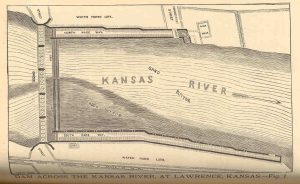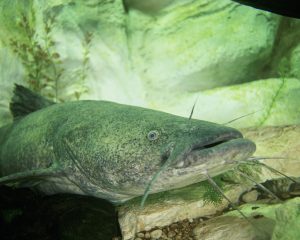In 1993, legendary riverman Tommy Burns put pen to paper to record his memories of hunting, trapping, and fishing along the Kansas River near Lawrence, Kansas. Thirty years later, a new copy of the book, entitled 60 Years on the Kaw River, is headed for the Helen Osma Local History Room at the Lawrence Public Library.
In his introduction to the book, local outdoor writer Ned Kehde, whose columns have appeared in the Lawrence Journal-World and In-Fisherman magazine, called Burns “the last fishmonger on the Kaw,” and described his memoir as “a folksy rhapsody devoid of any foofaraw.” An originator of the fishing style known as “Midwest finesse” (think light tackle, lots of fish) with a lure named after him (the ubiquitous “Nedrig”), Kehde knew Burns as a fellow master angler, and helped establish a collection of Burns-related materials in the University of Kansas Archives, where he worked as an archivist for 33 years. I was lucky enough to speak with Kehde recently about Tommy Burns and his memoir.
“Tommy was an exceptional character in this world. Intriguing, wonderful, kind,” Kehde said of his friend. “Back in the 40’s, 50’s and 60’s, hunting was a much bigger deal. Tommy was a duck hunter and knew where, when, and how to do it very well. All the bigwigs, Chamber of Commerce people, all the big guys in town were attracted to Tommy, not just because he knew what he was doing, but because he was a good man, a charming man.”
While Burns’ skills as a guide may have been formidable, his memoir contains numerous self-deprecating tales of mishaps on the river, one of which involves a 1938 duck hunt gone wrong on the river near Topeka.
“Looking ahead, I saw a big pipe sticking out from the south bank,” writes Burns. “Realizing this was a refuse pipe from the Hill Packing Co. I pulled the boat quickly to the right just in time to keep the sludge from sinking the boat, possibly destroying Harry and me, too. There was a small amount of the stinking sludge that did get into the boat and all over us. We sure did stink the rest of the day, and we had very little luck hunting ducks the rest of the trip to Perry.”
Kehde said Burns was known to row his boat up the Kaw from De Soto to Lawrence, a feat made possible only by his extensive knowledge of the river and craftsmanship as a boat builder. In a 2013 piece he wrote for In-Fisherman, Kehde describes how Burns could look at the surface of the river at any point and describe what lay beneath, including the composition of the riverbed, and any obstacles like boulders or logs.
“He had an intrinsic ability to know what was going on in nature and he could articulate it very well,” Kehde said. “When others were playing golf, watching baseball or drinking at the bar, he was watching the river. Many, many, many hours on the water are all that can do that.”
Burns trapped and hunted game birds and small mammals, whose pelts he skinned, cured and sold for income, but his favorite quarry was the flathead catfish, which he caught in large numbers with home-made hoop nets, and speared through holes in the ice in winter, methods astounding to modern fishermen, not least because they are no longer legal, Kehde pointed out.
In one reminiscence, Burns recalls a net so full of fish it nearly sank his boat. “I went back acrosss the river and picked up the other net and hooked the front hoop over the bow stem,” he writes. “However, when I laid my net oar down, I dropped it hard. This noise really scared the fish, and they all headed to the bottom of the river, pulling my boat down to the gunnel, which is the top of the boat’s side boards. I ran to the back of the boat to keep it from sinking.”
According to Kedhe, Burns could talk to anyone. “All these biologists were just amazed by Tommy, too,” Kedhe said. “Just by his ability to know what the river was. They knew it academically, but he knew it from being on the river 365 days a year for 50 or 60 years. He could talk to them, and they would listen to him.”
In some cases, Kedhe has written, Burns’ observations contradicted the conventional wisdom of scientists, as in this anecdote about an animal rarely seen in northeast Kansas. “I was at the rock bank on the Kaw below Eudora,” Burns writes in his memoir. “About 3:30 a.m. I heard what sounded like a big man calling for help. I turned my boat toward the north bank where the sound came from. It howled and I recognized it as a howl of a bear. About that time the cattle in the hill broke through the brush and were bawling and running from where the bear had howled. That night I went back to the creek. Nearby there were black bear tracks in the mud.”
Like the rest of the Osma Room collection, Burns' memoir doesn’t check out from the library, but at 97 pages, it's a quick read, and there may not be anyone more entertaining to spend a few hours with than the “King of the Kaw.”
“He’s a character Mark Twain would have loved to know and write about,” Kehde said. “It’s like he walked right out of Huckleberry Finn.”
A reading list of books in the Lawrence Public Library inspired by Tommy Burns:
-Dan Coleman is a Collection Development Librarian at Lawrence Public Library.





Add a comment to: The Return of the King